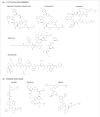Peptidomimetic therapeutics: scientific approaches and opportunities
- PMID: 27856346
- PMCID: PMC5759319
- DOI: 10.1016/j.drudis.2016.11.003
Peptidomimetic therapeutics: scientific approaches and opportunities
Abstract
Natural endogenously occurring peptides exhibit desirable medicinal properties, but are often limited in application by rapid proteolysis and inadequate membrane permeability. However, editing naturally occurring peptide sequences to develop peptidomimetic analogs created a promising class of therapeutics that can augment or inhibit molecular interactions. Here, we discuss a variety of chemical modifications, including l to d isomerization, cyclization, and unnatural amino acid substitution, as well as design strategies, such as attachment to cell-penetrating peptides, which are used to develop peptidomimetics. We also provide examples of approved peptidomimetics and discuss several compounds in clinical trials.
Copyright © 2016 Elsevier Ltd. All rights reserved.
Figures


References
-
- White CJ, Yudin AK. Contemporary strategies for peptide macrocyclization. Nat Chem. 2011;3:509–524. - PubMed
-
- Craik DJ, et al. The future of peptide-based drugs. Chem Biol Drug Des. 2013;81:136–147. - PubMed
-
- Uhlig T, et al. The emergence of peptides in the pharmaceutical business: from exploration to exploitation. EuPA Open Proteom. 2014;4:58–69.
-
- Fosgerau K, Hoffmann T. Peptide therapeutics: current status and future directions. Drug Discov Today. 2015;20:122–128. - PubMed
Publication types
MeSH terms
Substances
Grants and funding
LinkOut - more resources
Full Text Sources
Other Literature Sources

